Bontrager TLR 2013 Review
Bontrager TLR 2013 Review
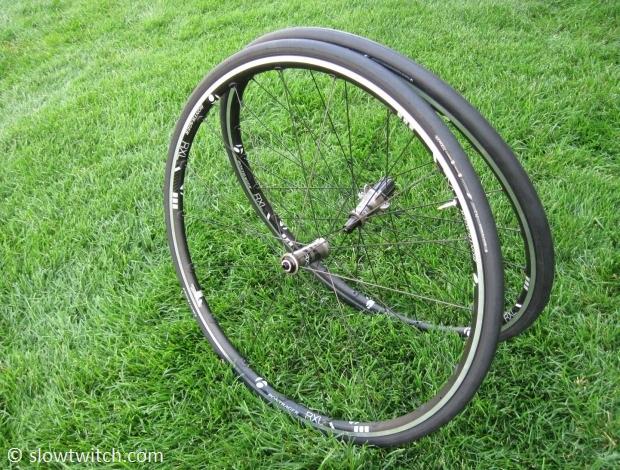
It’s a bird! It’s a plane! No… what is it? It sure isn’t Superman – and it’s not your typical review. It had me thrown off from my normal routine at first. It’s not a wheel review. It’s not a tire review. No, it’s not even a sealant review. It’s a system review. And quite an interesting concept at that.
This is a review of Bontrager’s new complete TLR road line-up. What does TLR mean? It’s short for TubeLess Ready – or Bontrager’s take on setting their own proprietary tubeless “standard”. They’ve had it for years in mountain bike wheels and tires, but it’s all-new for the road scene.
To begin, I will attempt to reassure you. The basic structure of the wheel line stays the same, and even the names are the same as in the past. Essentially they’ve done a massive overhaul in key areas – but actually made it rather easy to understand. In addition to the wheels, there are two new tires, and a brand-new latex-based sealant.
The Nitty Gritty
There are three key wheel models: Race, Race Lite, and Race X Lite. In that order, they go from heaviest to lightest – and cheapest to most expensive. All look fairly similar at a glance, and fill the same basic purpose… they’re shallow section aluminum wheels for training. Bontrager mentions that the top-end Race X Lite can also double as a racing wheel, but given its shallow rim profile, I’d venture a guess that they’re aiming the “race wheel” role at road racers (not triathletes). And really – you could race or train on anything you darn well please – so I try to avoid getting in to those discussions altogether. Lucky me, though, got to test the full-bling Race X Lite model.
As you could also expect, the hubs, spokes, and rims change throughout the lineup. The lowest end model features a very basic hub with standard J-bend spokes, and a heavier rim. The top-end model features hub internals from the DT Swiss 240, along with straight-pull bladed spokes and a lighter rim (pictured below). The middle “Race Lite” model falls somewhere in between. This is all standard fare for the industry. You pay more for more features.
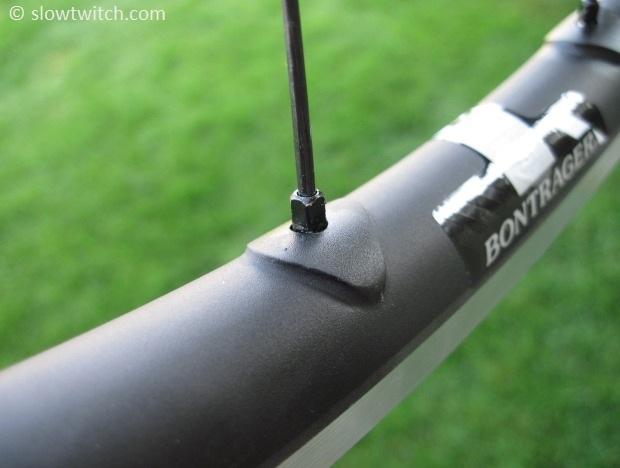
My test set of wheels are the highest-end Race X Lite, with DT Swiss 240 hub internals. Note that the rear hubs on the Race Lite and Race X Lite models are compatible with the new Shimano 11-speed standard (and retain compatibility with 9 and 10-speed systems). There is also a separate option for Campagnolo compatibility.
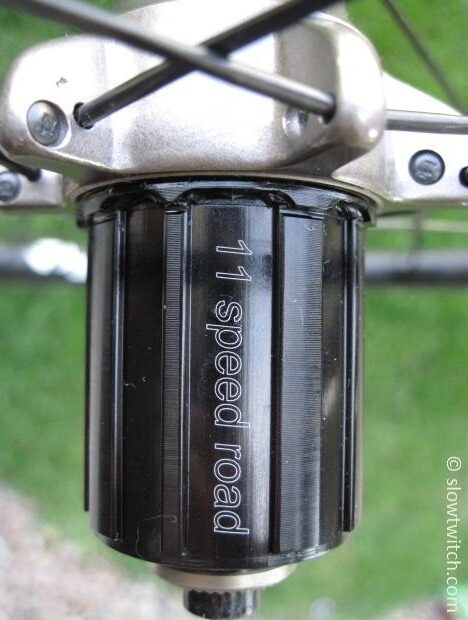
The front hub features the now-standard minimalist Bontrager design and straight-pull spokes:
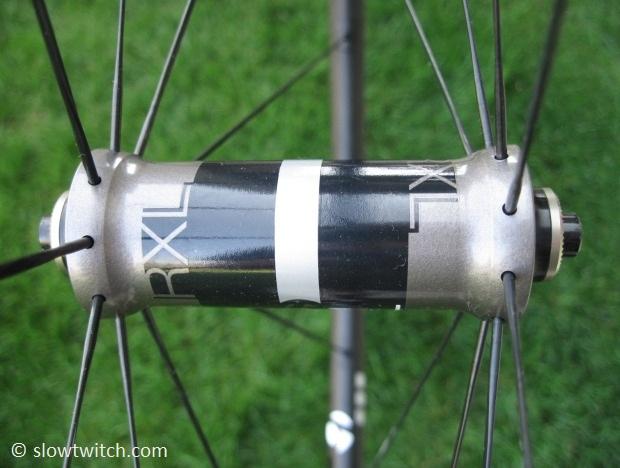
What, then, is the big update to this wheel line-up? In a few words – it’s all about the rim, baby. First off, Bontrager got on the wide rim bandwagon. Yes, this is a 23mm rim (measured outside-to-outside at the braking surfaces). Its official measurement is ETRTO 622-17c. For the geeks out there, that means it fits tires of the same diameter (622 – or “700c”), and has an internal width of 17mm.
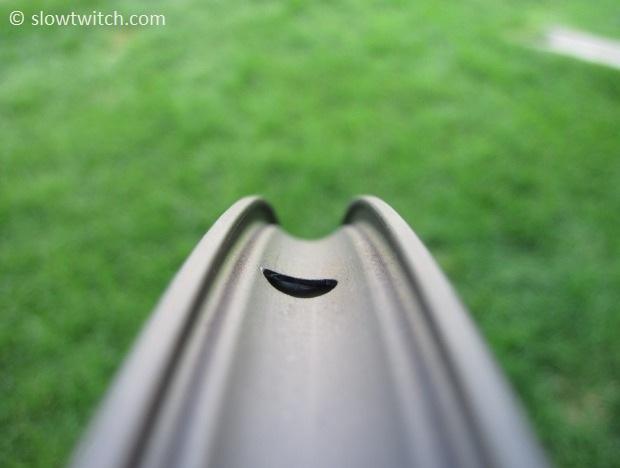
Next up, these rims have a very unique internal shape and accompanying rim strip – and this is where the TLR part comes in. If you want to run standard tires with inner tubes, you are more than welcome to. Just use a standard rim tape, such as Velox cloth. Put on your favorite tires and tubes, and ride to your heart’s content.
However, however… if you want to run tubeless, you use the Bontrager TLR plastic rim strip. This covers up all of the spoke holes completely, and effectively converts the internal shape of the rim to Road Tubeless.
Bontrager provided this handy diagram. “1” is the special rim, “2” is the TLR rim strip, and “3” is the TLR tire with sealant:
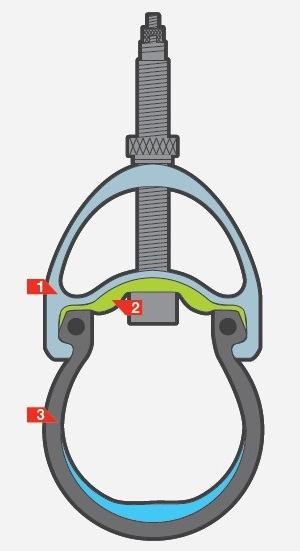
At first glance, I found this very interesting. To be honest, I thought it would be cheap or flimsy. I thought it wouldn’t likely seal very well. Coming from the manufacturing side of the industry, I know how hard it can be to hold tolerances, and this just looked to be far-fetched as a realistic long-term tubeless solution. What to do? Test it!
The flat spot on the rim strip is intended to mate perfectly with a tubeless valve stem:
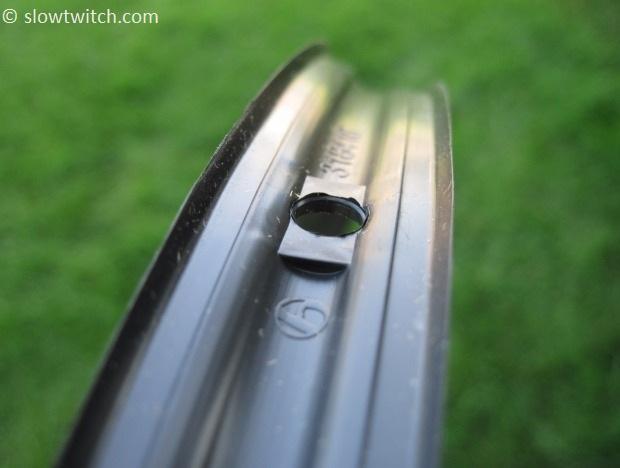
I began by installing the rim strip at the valve area first:
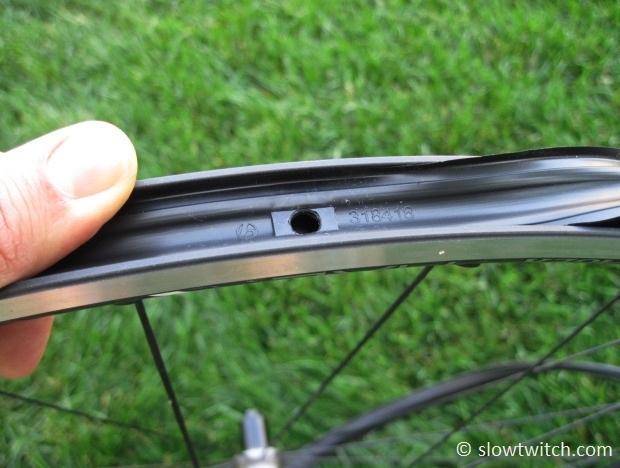
Be sure to put the valve in right away (i.e. before you start putting the rim tape all the way around the rest of the rim). This will keep the valve hole in the rim strip lined up with the valve hole in the rim. Also be sure to tighten the nut down very snug.
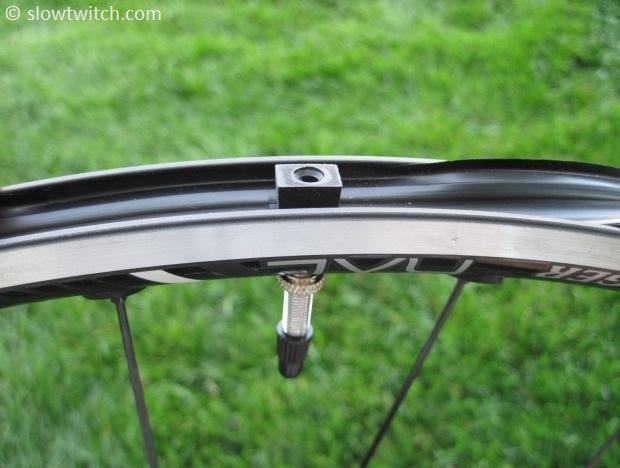
Stretch the rim strip all the way around the rest of the rim. It’s reminiscent of stretching a tubular tire on to a rim, only easier. Once it is completely installed, notice how the inside of the rim really does look like a road tubeless rim:
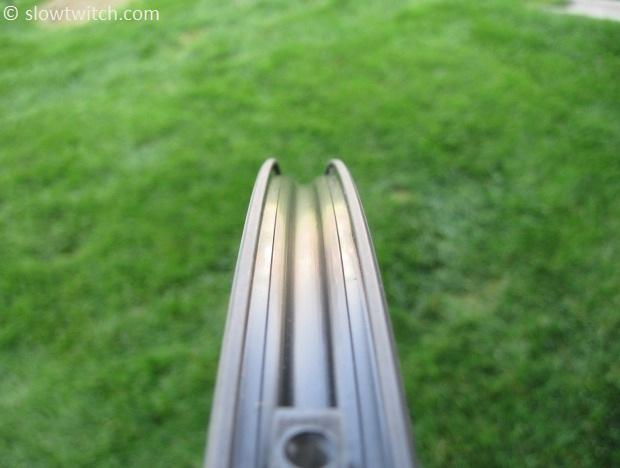
I was actually quite impressed with the fit. It went on firmly enough to feel confidence-inspiring, but not so difficult that I was cursing at it.
Next up, we need some tires. Bontrager has two new tubeless offerings – their R2 and R3 TLR. Both are available in 23mm or 25mm width. My test kit included R3’s in both widths.
I opted to go with the 25mm tires. For one, I just prefer wide tires in general. They tend to ride better because I can use lower pressure – which goes double for tubeless.
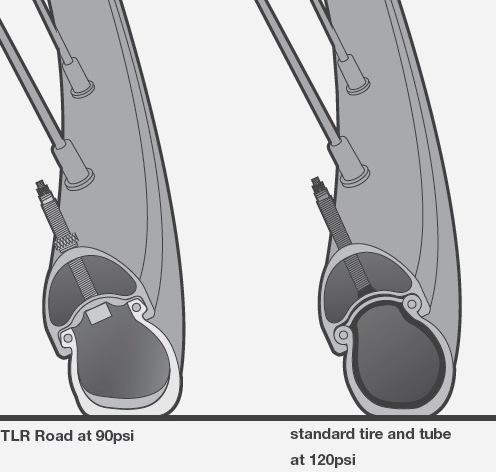
I was still left with one unanswered question. As I’ve previously written about, the ETRTO standards dictate what range of tire widths work with a given rim width. If a rim or tire is too wide for the other, you can have a dangerous situation (think of trying to use a 20mm width tire on a 30mm width rim). The 17c width rim has exploded with popularity on the road and triathlon scene in the past year or two – BUT it is technically too wide to be used with a 700x23mm width clincher tire. Rims such as this include the Hed Ardennes and Jet, Saris’ aluminum training wheel, 3T’s Accellero, and the Bontrager Aura 5. Clearly, many people are using 23mm tires on these rims with success – and all manufacturers seem to agree that you aren’t supposed to use anything narrower than 23mm. But the ETRTO specification stands – and so far nobody has an answer for this question.
My 25mm R3 tire:
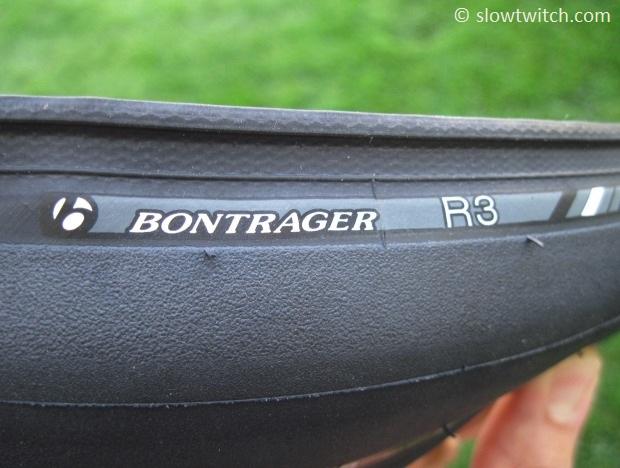
If you’ve ever worked with tubeless tires, you know that this point in the installation is where two key pieces of optional equipment might be necessary:
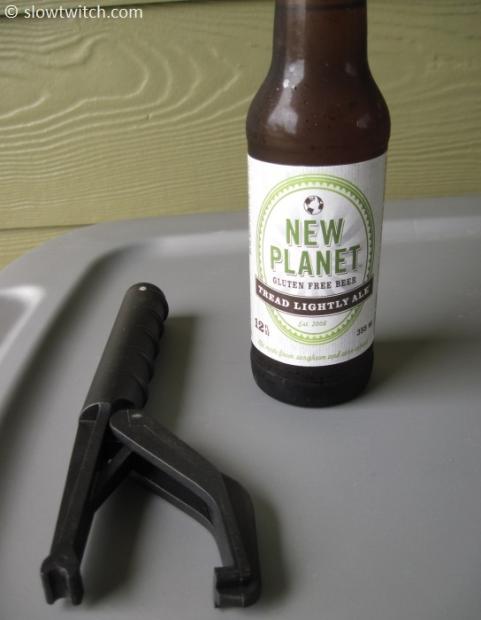
First is a “cheater” tire lever, and second is a frosty fermented beverage of your choice (of course, assuming you’re of age for such a beverage). I went with New Planet’s gluten free Tread Lightly Ale.
You see, part of the premise behind tubeless is that you need an airtight seal at the tire bead. This assumes that that tire/rim interface will be tight. In the case of these Bontrager wheels and tires, I found it to hold true.
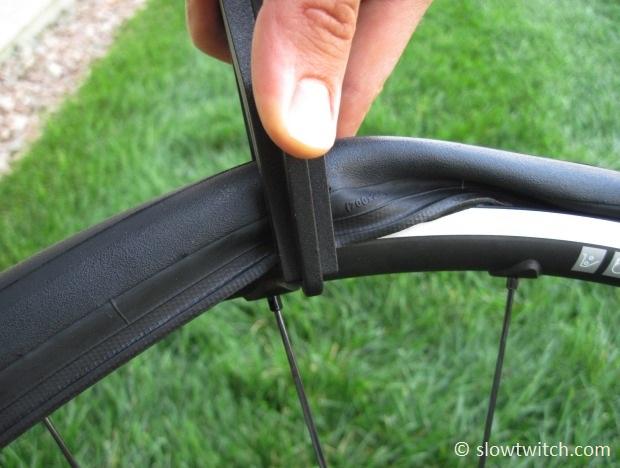
However, it I wouldn’t call this wheel and tire combination to be especially difficult. I’ve certainly had worse. It may have been possible without the super tire lever, but I wanted to avoid blistered thumbs, or needing too many more of those beverages.
Now comes the real test – The Pump Test. And this is where the tightness of the tire installation really shows its true colors. With these wheels and tires, I was very pleased to find that they held air with no sealant at all. That’s very, very impressive. In contrast, I’ve had tubeless setups that install very easy, but you need an air compressor or CO2 cartridge to achieve inflation (to “blast” the tire beads in to place very quickly). The holy grail is a tire that installs easy and inflates with a floor pump, but I’ve yet to find anything that achieves such magic.
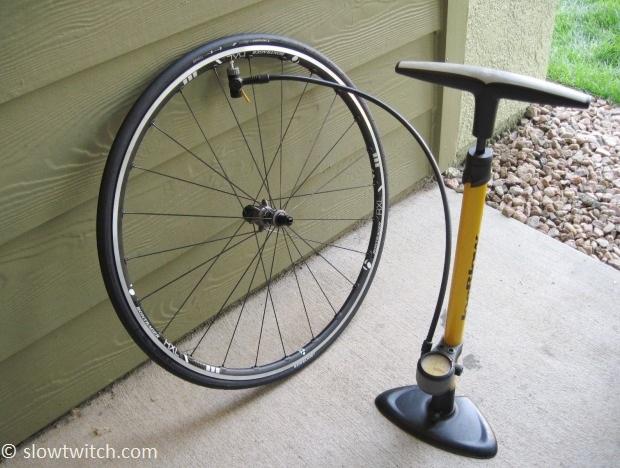
After the test pump (sans sealant), I deflated the tire, and removed the valve core with my trusty Stan’s core removing tool:
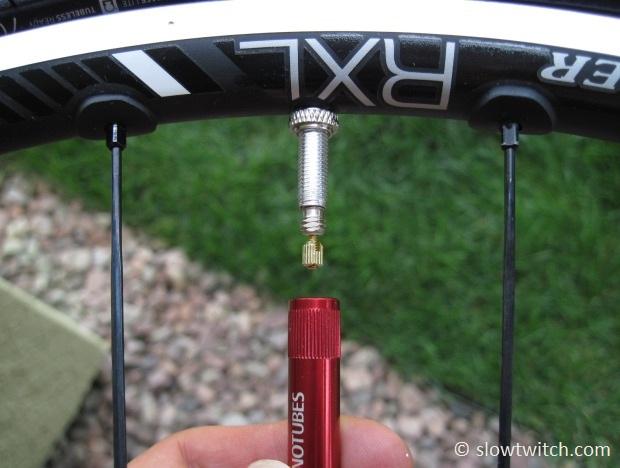
I then brought out the new Bontrager sealant. They say this stuff is latex-based and free of ammonia, so it will not cause corrosion or rot your tires. It is a proprietary mix, which they say evaporates slower than the competition, and you do not need to use as much volume – only one ounce per road tire.
I used my trusty Stan’s injector tool to install the sealant. While Bontrager says that you only need one ounce, I used two per tire. I live in the dry climate of Colorado, and simply want to limit the number of times I have to re-inject more sealant as it dries. It costs me a little bit of weight, but is worth the time savings (for me).
Per the directions, I shook the sealant bottle vigorously, and then dumped two ounces in to the injector. Note that I kink the hose intentionally to hold the fluid in place and get an accurate measurement.
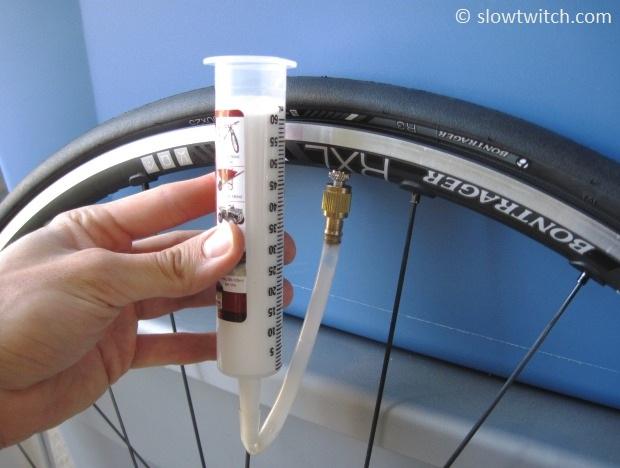
In goes the sealant:
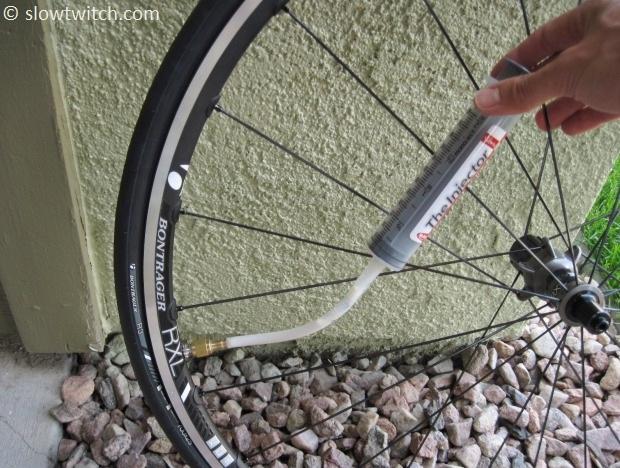
After that, I reinstalled the valve core and pumped up the tires. For good measure, I always do a little bit of the “Sealant Rain Dance” – spin the wheel, shake it around, and cut foot loose. This just ensures that the sealant coats the entire inside of the tire and seals any imperfections of the tire bead.
I’ve had the wheels pumped up but un-ridden for about a week, and they appear to be holding air very well. I look forward to riding the wheels to many comfortable and (hopefully) flat-free miles.
Are They For You?
The best thing about these new wheels is the fact that you have options. If you buy a Trek bike that comes stock with the Race Lite model, for example, you can ride them as-is with the stock tires and tubes. They’re relatively inexpensive and get the job done. If, however, you want them to ride smooth as gravy and upgrade to tubeless, all you need to do is buy the upgrade kit for $200. It includes two R3 TLR tires, two TLR rim strips, two TLR valves, a bottle of sealant, and a valve tool:
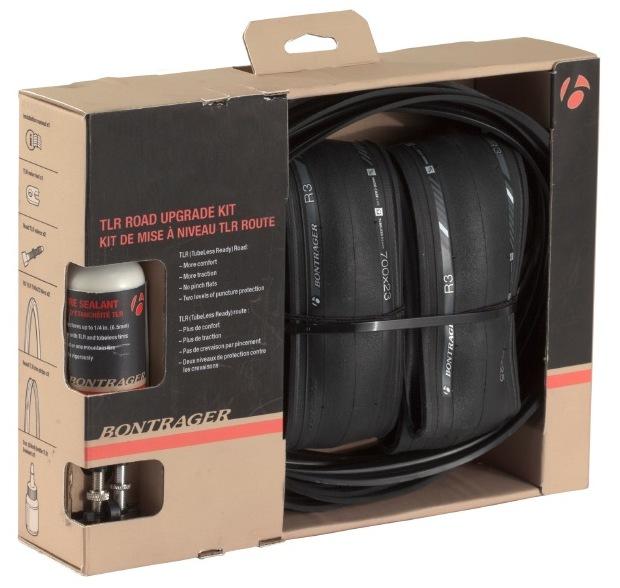
They’ve made it incredibly easy and surprisingly inexpensive to have whatever you want. As well, the move to 23mm wide rims makes it easier for those of us who race on wide rims, by minimizing the amount of brake adjustments necessary when swapping wheels.
For now, this technology is reserved for only their aluminum training wheels. Bontrager’s representative did mention, however, that they are “looking into” the possibility of bringing it to other wheels, such as their 50mm deep Aura 5, or even the Aeolus D3 carbon clinchers. I would personally love to see them make that move. It would secure Bontrager as one of the few tubeless-compatible race wheels, and the only one with a full-carbon rim (in the case of the Aeolus D3 clinchers).
When asked about the rolling resistance of the new tires, Bontrager responded that their own measurements put them equal or better than all of the tubeless tires on the market today. That unfortunately does not include the yet-to-be-released Schwalbe road tubeless tire, which is purported to be a very fast roller. Ultimately it will take independent testing to really give us a clear look at the situation, but Bontrager isn’t ignoring the Crr side of the equation.
The most impressive thing about the whole new product line – if you ask me – is simply the fact that Bontrager got on the bandwagon with several new technologies in one fell swoop, and on a large scale. I don’t know of any other high-selling “training wheel” in existence that does everything these do – and especially not at this price. They’ve gone wide rim, tubeless compatible, AND 11-speed. If they can add in a legitimate aero-profile carbon rim to the mix, I think they’ll be in a league of their own – at least until the competition can react.
Race X Lite
MSRP $1,000
1,480 grams/pair
23mm wide OSB alloy rims (622×17)
Locally reinforced spoke nodes reduce rim weight without sacrificing strength
Bontrager designed hubs with DT 240 star ratchet internals, nail head spokes and stacked drive-side lacing
18 front and 24 rear DT 14/17g bladed spokes with Alpina locking alloy nipples
Includes Bontrager internal-cam skewers, TLR rim strips and TLR valve cores
Compatible with both Shimano and SRAM 9/10 spd and Shimano 11spd cassettes
Campy compatible with free hub part number 276362
Compatible with both traditional, TLR and road tubeless clincher tires
No rider weight restrictions
Race Lite
MSRP $700
1,500 grams/pair
23mm wide OSB alloy rims (622×17)
Nail head spokes and stacked drive-side lacing
Bontrager designed, sealed cartridge bearing hubs with 3-pawl drive mechanism
18 front and 24 rear 14/15g bladed spokes with Alpina locking alloy nipples
Includes Bontrager internal-cam skewers, TLR rim strips and TLR valve cores
Compatible with both Shimano and SRAM 9/10 spd and Shimano 11spd cassettes
Campy compatible with free hub part number 420390
Compatible with both traditional, TLR and road tubeless clincher tires
No rider weight restrictions
Race
MSRP $500
1,690 grams/pair
23mm wide OSB alloy rims (622×17)
Forged aluminum cartridge bearing hubs features updated flange design
18 front and 24 rear 14/15g bladed spokes with Alpina locking alloy nipples
Includes Bontrager internal-cam skewers, TLR rim strips and TLR valve cores
Compatible with both Shimano and SRAM 9/10 spd cassettes
Compatible with both traditional, TLR and road tubeless clincher tires
No rider weight restrictions
R3 TLR tire
23 or 25mm
Weight: 270g
120tpi casing
Kevlar beads
MSRP $80/tire
R2 TLR tire
23 or 25mm
Weight: 305g
60tpi casing
Kevlar beads
MSRP $60/tire
New TLR sealant
Latex-based, ammonia free
Made in USA
Seals punctures up to ¼ inch
1 oz for road, 2 oz for MTB
32 oz for $25
2 oz for $2



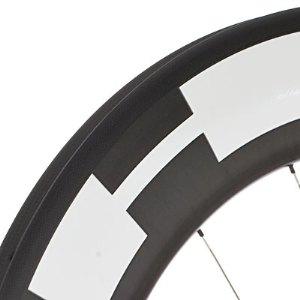
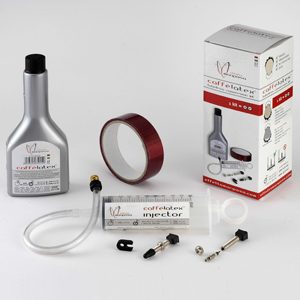
Start the discussion at forum.slowtwitch.com